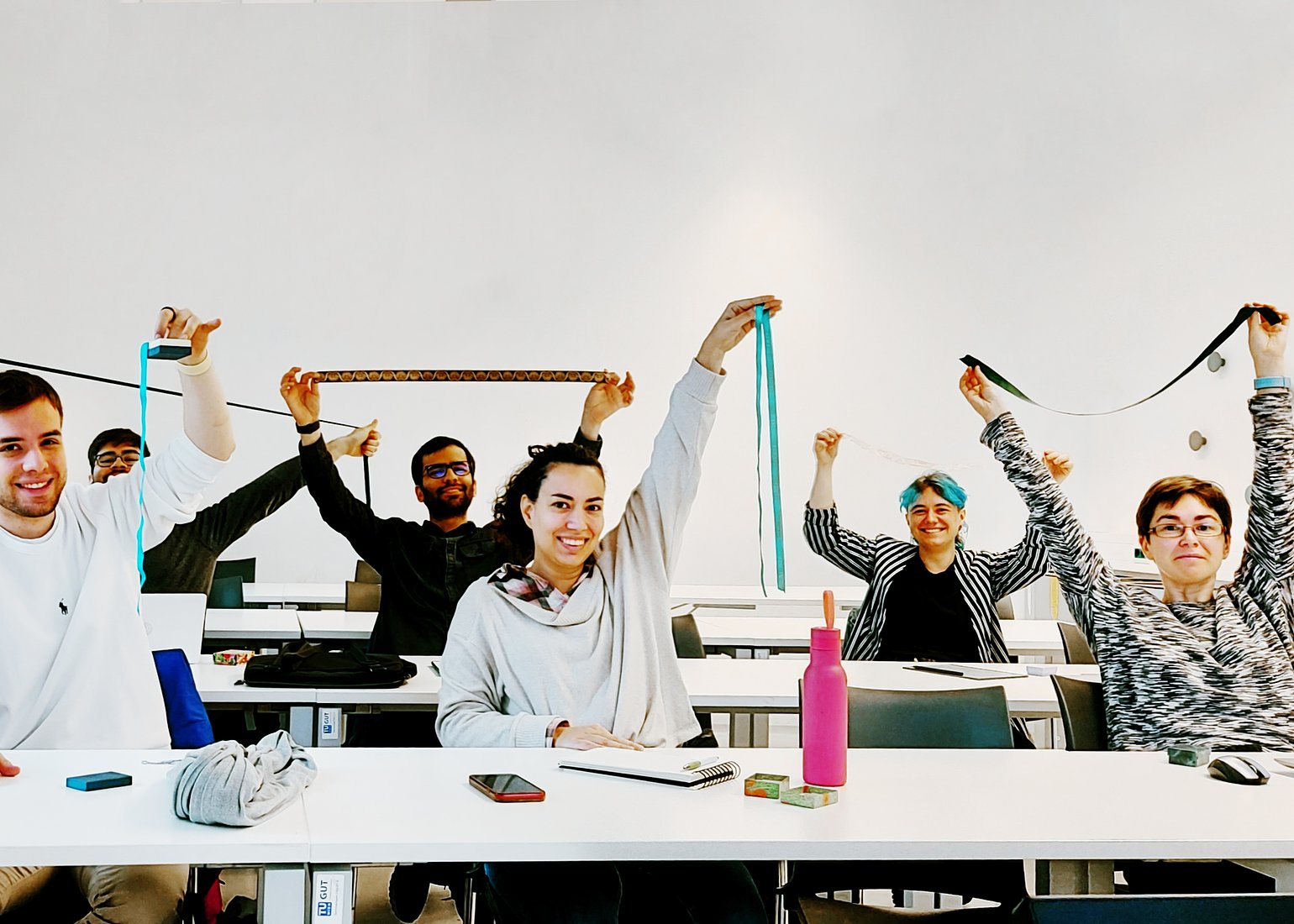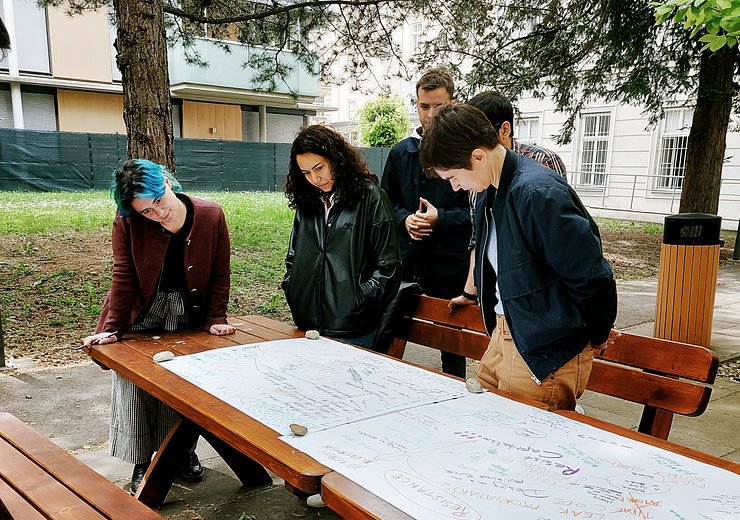Dare to Care – Designing Differently, Imagining Collaboratively
How can we create a just and sustainable future? Our students worked with guest professor Ann Light on technology and planet-centric design.

Have you ever imagined a different world? What would have to change? What could we have done differently in the past? How could a just and sustainable future look? What role can technology play in it? And what does „planet-centric design“ mean?
Let’s start with some answers: TU Wien Informatics had the pleasure to host Ann Light from the Universities of Sussex (UK) and Malmö University (Sweden) as a guest professor of the TU Wien Informatics Doctoral School. During her stay in the summer semester of 2023, she held a public talk on planet-centric design and finding socio-technical alternatives, engaged in extensive discussions with hosting Research Unit for Human Computer Interaction, and, most importantly, taught the course “Designing Differently, Imagining Collaboratively: The Need for Socio-Technical Alternatives” as part of our Doctoral School.
Envisioning planet-centric design
Over the span of ten sessions, our students embarked on a transformative journey, exploring diverse ways to look at sustainable, planet-centric design. ‘Planet-centric design’ in tech is an approach that prioritizes the well-being of the planet, its ecosystems, and the beings on it – including but not limited to us humans. By incorporating renewable resources, energy efficiency, inclusive perspectives, and more, it considers the long-term societal and environmental impact of technology and strives to minimize negative effects.
Alas, the journey starts with oneself: Ann Light encouraged the young researchers to contextualize not only their own self-image but also the past and future of their discipline. How do they see themselves as researchers, how do they work together, and develop their field? The students were challenged to review their own values, beyond their roles as designers and engineers, and given the opportunity to envision their discipline 30 years from now. “Coming from a different background, the course managed to guide me into a new way of interpreting the usual problem-solution iteration of engineering […], Allessio Colucci is convinced “it showed me how this process is not a solitary one, but there are plenty of other people willing to collaborate to achieve a better future […].”
World building, machine building
“This will not be tidy” is Ann Lights’ overarching theme, and conviction. Thinking outside the box is necessary for unique solutions, that’s why the students were tasked to get messy for building new worlds within the course. What does a world where rubber is the most important resource look like? How could a world where all life is truly worthy of our respect work? A focus of Ann Lights’ research is creating a collaborative world, involving, but not driven by technology. For this, she coined the term ‘world machines’, addressing systems that combine technology and social collaboration in tackling global challenges. World machines harness computational power to connect people across the planet and promote collective action. These machines aim to resist the prevalent trend of networks being used primarily for surveillance, military purposes, or economic gain, instead emphasizing their potential for collaborative purposes. The students discussed different global sharing possibilities, like micro-libraries, communal tool sheds, community gardens, time banks, etc.
But how does one create a community and design collectively, when values increasingly drift apart? In today’s rapidly evolving technological landscape, contrasting opinions stand side by side. Simplistic views, like “AI is bad/good” obscure the dialogues necessary for constructively building our future. Ann Light encouraged the students to challenge their own views in an intense debate on AI, showing them how to endure and release tensions of polarizing viewpoints to ultimately collaborate. “[…] it was nice to see how ‘design’ can encompass such a vast array of meanings,” Ekaterina Osipova states, “designing as a practice is not just creating finished, closed-off artifacts that neatly fit into a set of pre-defined problems. Instead, designing can take place through collaborative thinking, telling stories, and experimenting. It can be messy, it can be lo-fi, and it can bear contradictions and tensions.”
More than human
The class further explored ways to include the rights of nature and other beings on the planet in decision-making and design processes. “[…] as an HCI researcher, I mostly thought about people-centric technologies, rather than planet-centric ones”, Rafael Vrecar points out. “I now firmly believe that we also have to put the planet and its variety of eco-systems into consideration when assessing the impact technologies have, and the benefit or harms they might bring.”
In several group projects with videos, app mock-ups and more, the students tackled issues like endangered swamps and how technology can support their revival, tensions regarding nuclear energy production and technologies, and wild-life re-claims. “[..] We have learned that if we don’t dare to dream, we will never really solve problems - just manage them more efficiently,” Silvia-Kay Kender concludes.
The students want to thank Ann Light for a truly inspiring course. A detailed summary of the course by Rafael Vrecar can be found below.
-
PDF / 162 KB / Ann Light Course Recap_May 2023_Rafael Vrecar.pdf
About Ann Light
Ann Light is Professor of Design and Creative Technology, University of Sussex, UK and Professor of Interaction Design, Social Change and Sustainability at Malmö University, Sweden. She is a design researcher and interaction theorist, specializing in participatory practice, human-technology relations and collaborative future-making. Her research has focused on the politics, ethics and agency of design, and especially co-design in communities, exploring social activism at neighbourhood level, investigating the design of sharing structures and questioning the boundaries of participation. Regarding the social, technological and ecological as inextricably linked, over the last few years she has turned to consider climate collapse and the stress that current systems put on the planet, believing creative remaking of relations is needed for liveable futures and looking at ways that socially engaged art and design can find potential in difficult places and offer visions of fairer worlds. She is co-creator of the CreaTures Framework, prepared as part of the European Union project Creative Practices for Transformative Futures, she recently completed work on Social Justice in the Digital Economy, a UK platform for research into more equal societies, and has two new EU projects starting this year, on ReWorlding and Bauhaus of the Seas.
Curious about our other news? Subscribe to our news feed, calendar, or newsletter, or follow us on social media.





